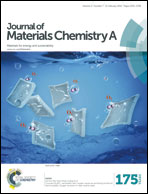Highly efficient visible-light-driven CO2 reduction to formate by a new anthracene-based zirconium MOF via dual catalytic routes†
Abstract
A new microporous robust zirconium metal–organic framework (Zr-MOF), NNU-28, has been synthesized and employed as a visible-light photocatalyst for carbon dioxide (CO2) reduction to produce formate. NNU-28 is constructed by using a visible light responsive organic ligand derived from an anthracene group. Studies reveal that the as-prepared Zr-MOF shows desirable characteristics including excellent chemical and thermal stability, high CO2 uptake, broad-band visible light absorption and efficient photoinduced charge generation. Remarkably, NNU-28 is highly efficient for visible-light-driven CO2 reduction with a formate formation rate of 183.3 μmol h−1 mmolMOF−1, which is among the highest performances of Zr-MOFs. Both photocatalytic experiments and electron paramagnetic resonance (EPR) studies reveal that both the inorganic building unit Zr6 oxo cluster and the anthracene-based ligand contribute to the highly efficient photocatalysis of CO2 reduction. The dual photocatalytic routes are demonstrated here to be more efficient for visible-light-driven CO2 photoreduction than that typically relying on a ligand-to-metal charge transfer process, illustrating a new strategy to design and synthesize novel visible-light photocatalysts for CO2 reduction with high efficiency.


 Please wait while we load your content...
Please wait while we load your content...